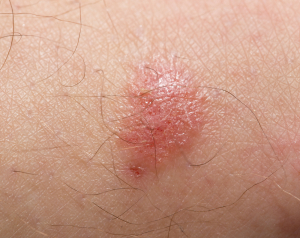Introduction
Tinea infections are fungal skin infections. The popular name for tinea infections is ringworm, probably because often the appearance of the rash is ring-like or worm-like. They can masquerade with many disguises; essentially there are six common presentations as shown below. Many fungus infections of the skin belong into the same group of “dermatophyte infections”, and often they respond well to the same antifungal agents.
Here is a link to a site that depicts tinea corporis: Picture of ringworm infection.(thanks to www.nlm.nih.gov/medlineplus for this link).
Occasionally a fungus infection of the skin becomes a diagnostic problem as it can look like eczema, psoriasis or other skin disease.
The treating physician will have to re-evaluate the patient, if a treatment course with a medication does not heal the condition. At this point another option would be to refer the patient to a skin specialist and I will often mention this in the subchapters that deal with the various forms of ringworm (see links in the above table). This is particularly important, if there is a superinfection of the skin condition with another bacterial or fungal bug or if there is an underlying skin cancer that has been super-infected with ringworm.
Ringworm (common types of ringworm)
_______________________________________________________
Athlete’s foot or foot fungus (tinea pedis) : fungi like to grow in moist skin between toes
Skin fungus (tinea corporis) : causes ring shape rash that spreads on body
Scalp fungus (tinea capitis): might initially look like dandruff, leads to transitory loss of hair
Nail fungus (tinea unguium) : without treatment can destroy nail
Jock itch (tinea cruris) : affects upper inner thighs, more common during the summer
Ringworm of the beard : (tinea barbae) : in agricultural workers, otherwise bacterial infection more common
_______________________________________________________
References:
1.The Merck Manual, 7th edition, by M. H. Beers et al., Whitehouse Station, N.J., 1999. Chapter 265.
2.James Chin et al., Editors: Control of Communicable Diseases Manual, 17th edition, 2000, American Public Health Association
3.The Merck Manual, 7th edition, by M. H. Beers et al., Whitehouse Station, N.J., 1999. Chapter 112.
4. The Merck Manual, 7th edition, by M. H. Beers et al., Whitehouse Station, N.J., 1999. Chapter 115.
5. The Merck Manual, 7th edition, by M. H. Beers et al., Whitehouse Station, N.J., 1999. Chapter 113.







